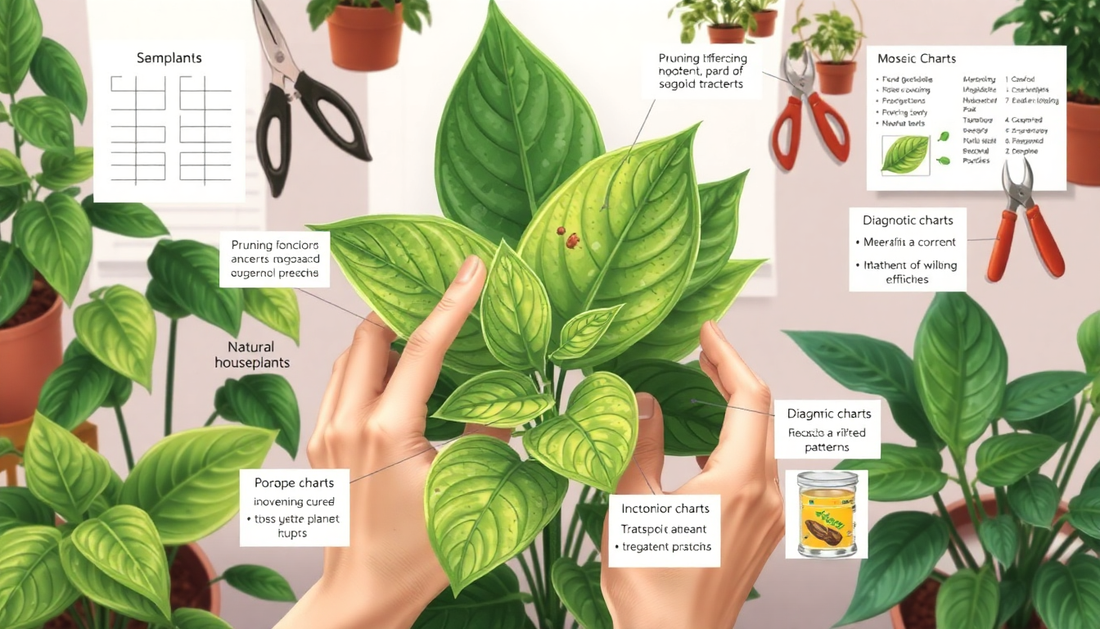
Identifying and Treating Viral Infections in Your Indoor Plants
As passionate gardeners, we all strive to keep our indoor plants healthy and thriving. However, one of the most frustrating challenges we may face is dealing with viral infections. These invisible invaders can wreak havoc on our beloved greenery, causing unsightly symptoms and potentially threatening the entire plant's well-being. In this comprehensive guide, we'll explore the signs of viral infections, the steps to diagnose and treat them, and the best practices to prevent the spread of these diseases in your indoor garden.
Understanding Plant Viral Infections
Plant viruses are microscopic pathogens that can infect a wide range of plant species, including the indoor plants we cherish. These viruses hijack the plant's cells, using them to replicate and spread throughout the plant's tissues. Unlike bacterial or fungal infections, viral diseases are not caused by living organisms but rather by genetic material that can only reproduce within a host plant.
The most common viral infections affecting indoor plants include the Mosaic virus, the Tomato Spotted Wilt virus, and the Cucumber Mosaic virus. These viruses can be transmitted through various means, such as infected plant material, contaminated tools, or even by sap-sucking insects like aphids and thrips.
Identifying the Symptoms of Viral Infections
Recognizing the early signs of a viral infection is crucial for effective treatment and prevention. Here are some of the most common symptoms to look out for:
Mosaic Patterns
One of the telltale signs of a viral infection is the appearance of mosaic-like patterns on the leaves. These irregular splotches of discoloration, often alternating between green and yellow or white, are a result of the virus disrupting the plant's chlorophyll production.
Leaf Distortion
Viral infections can also cause leaves to become misshapen, curled, or puckered. This is due to the virus interfering with the plant's normal growth and development processes.
Stunted Growth
Infected plants may exhibit stunted growth, with smaller leaves, shorter stems, and an overall diminished appearance compared to healthy plants.
Necrotic Spots
In some cases, viral infections can lead to the formation of necrotic (dead) spots or lesions on the leaves, stems, or flowers. These areas appear as brown or black spots that can spread throughout the plant.
Reduced Flowering or Fruit Production
Severe viral infections can significantly impact a plant's ability to produce flowers or fruit, leading to a disappointing harvest or lack of blooms.
Diagnosing Viral Infections
If you suspect your indoor plant is suffering from a viral infection, it's important to confirm the diagnosis before attempting any treatment. Here are a few steps you can take:
-
Visual Inspection: Carefully examine your plant for the symptoms mentioned above, taking note of the specific patterns and locations of the affected areas.
-
Consult Plant Identification Resources: Compare the symptoms you observe with images and descriptions of common viral infections in indoor plants. Online resources and plant identification apps can be helpful in this process.
-
Seek Professional Assistance: If you're still unsure about the diagnosis, consider reaching out to a local plant clinic, university extension service, or a professional horticulturist. They can often provide a more accurate diagnosis through specialized testing.
Treating Viral Infections
Unfortunately, there is no "cure" for viral infections in plants, as the virus is embedded within the plant's cells. However, there are several steps you can take to manage the infection and prevent its spread:
Isolate the Infected Plant
Immediately isolate the affected plant from your other indoor plants to prevent the virus from spreading. This may involve moving the plant to a separate room or area, or even discarding the plant if the infection is severe.
Prune Affected Foliage
Carefully remove any leaves, stems, or flowers that show signs of viral infection. Be sure to disinfect your pruning tools between cuts to avoid transferring the virus to healthy parts of the plant.
Improve Growing Conditions
Ensure your indoor plants are receiving the optimal amount of light, water, and nutrients. Healthy, stress-free plants are better equipped to withstand and recover from viral infections.
Consider Biological Controls
In some cases, introducing beneficial insects or microorganisms that prey on or compete with the virus-carrying pests can help manage the infection.
Prevent Future Outbreaks
Thoroughly clean and disinfect your gardening tools, work surfaces, and any other equipment that comes into contact with your plants. This helps eliminate the potential for the virus to spread.
Preventing Viral Infections
The best defense against viral infections in your indoor plants is a proactive approach to prevention. Here are some tips to keep your plants healthy and virus-free:
Source Healthy Plants
When acquiring new indoor plants, be sure to purchase them from reputable nurseries or growers that follow strict disease-prevention protocols.
Quarantine New Plants
Whenever you introduce a new plant to your indoor garden, keep it isolated for a few weeks to monitor for any signs of disease before integrating it with your existing plants.
Practice Good Hygiene
Regularly wash your hands, disinfect tools, and avoid touching healthy plants after handling infected ones. This helps minimize the risk of transferring the virus.
Manage Pests
Keep a close eye on your indoor plants for any signs of sap-sucking insects, such as aphids or thrips, which can act as vectors for viral transmission.
By understanding the signs of viral infections, following proper diagnostic and treatment protocols, and implementing preventive measures, you can protect your indoor plants and maintain a thriving, healthy garden. Remember, early detection and a proactive approach are key to successfully managing viral diseases in your indoor plant collection.







No comments